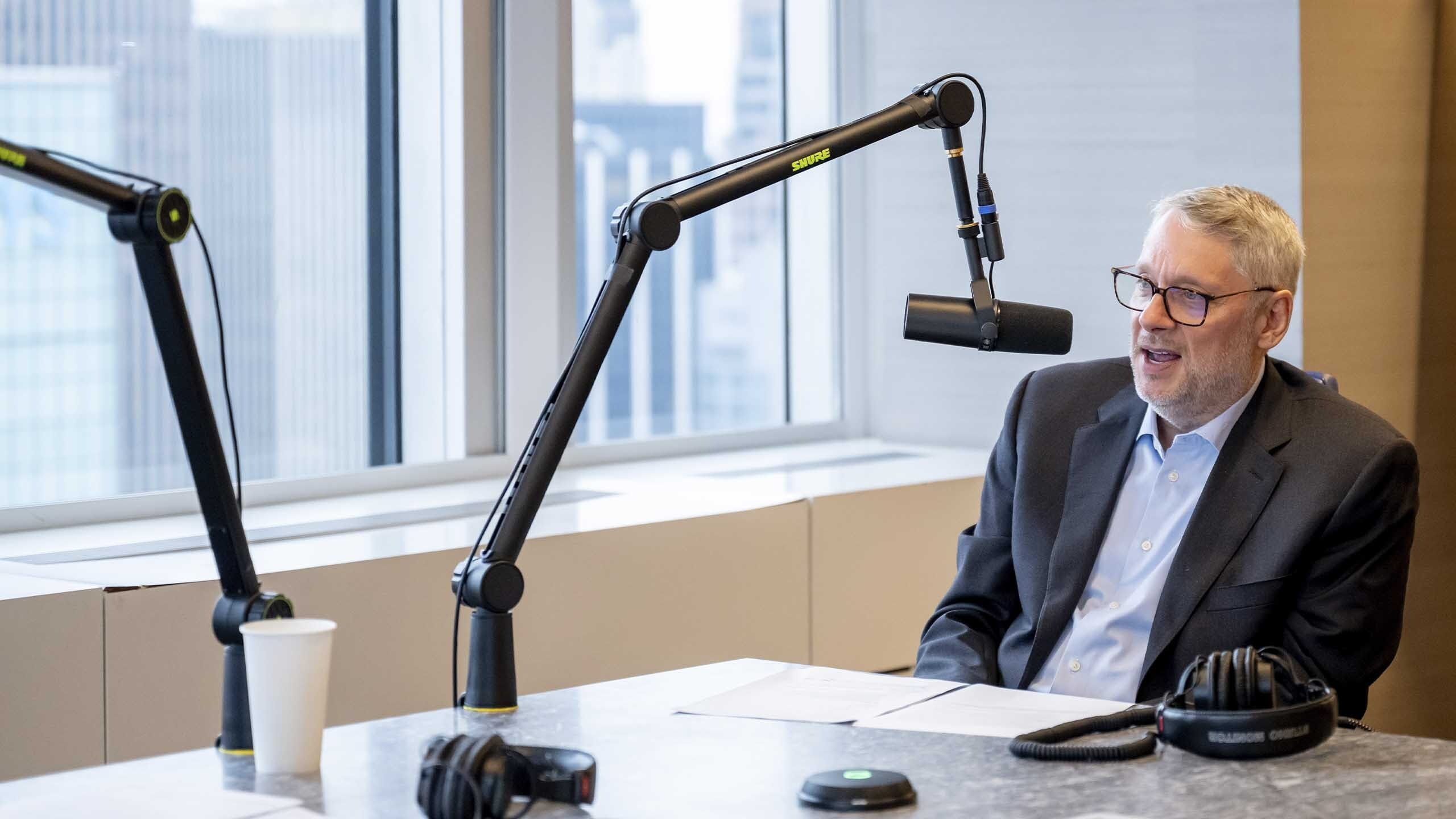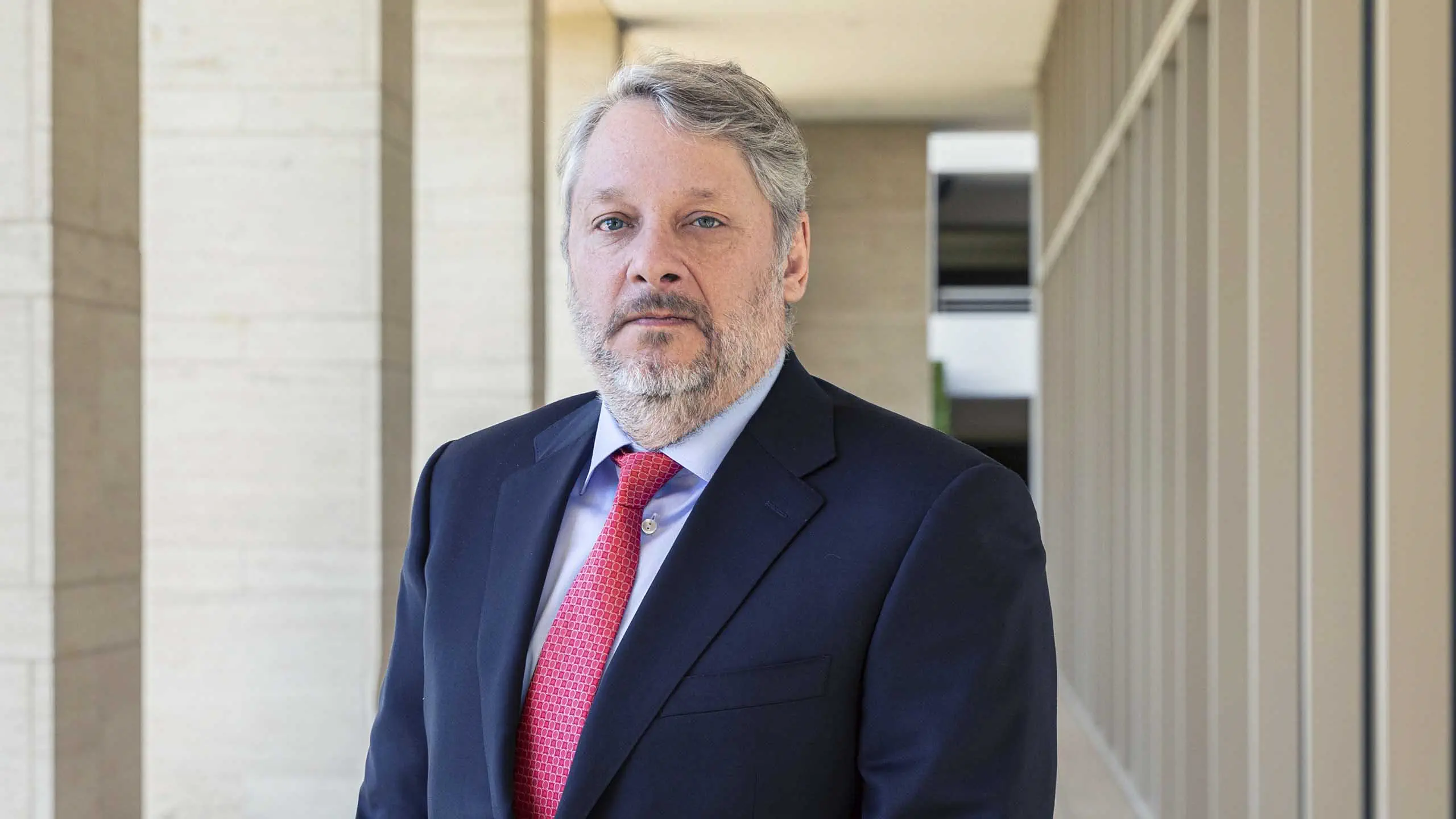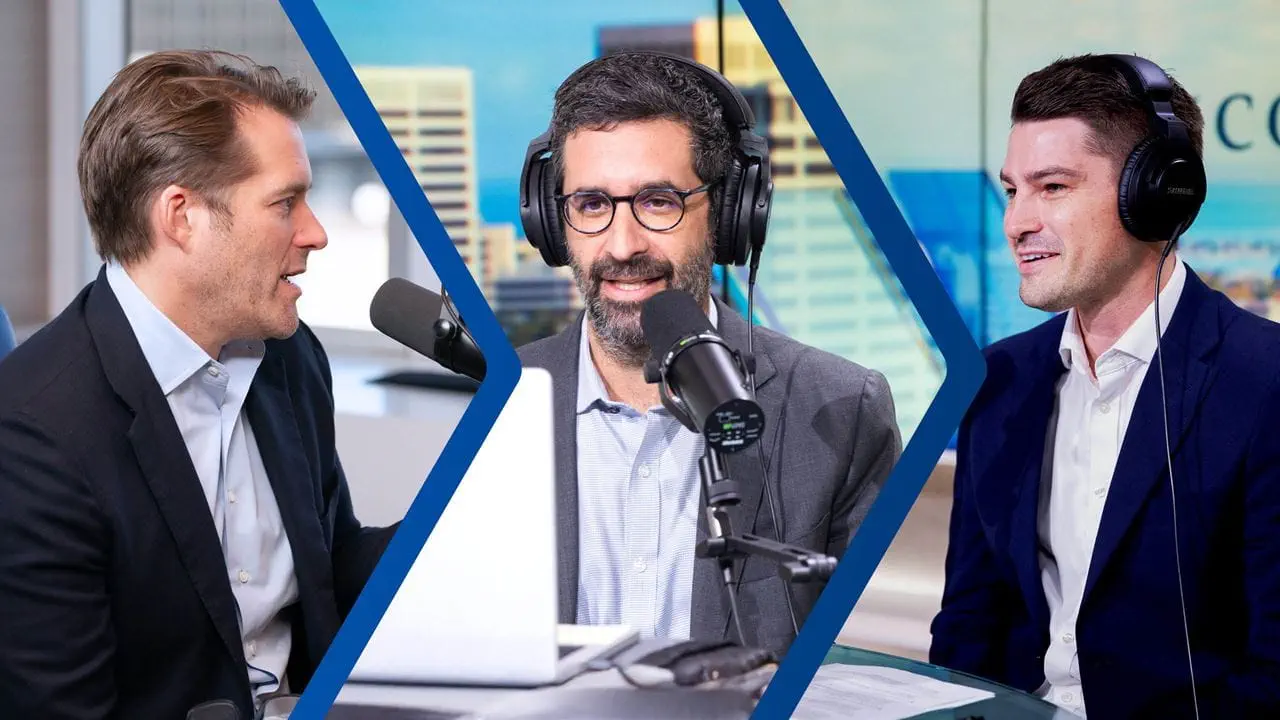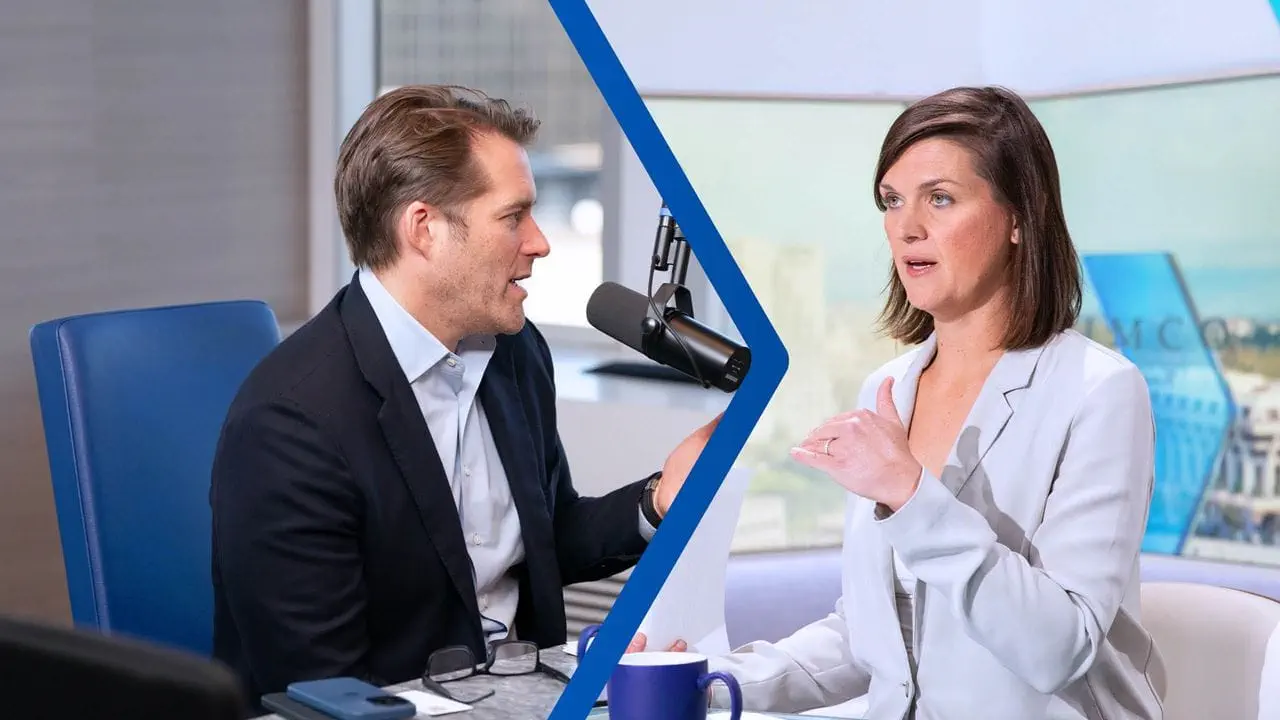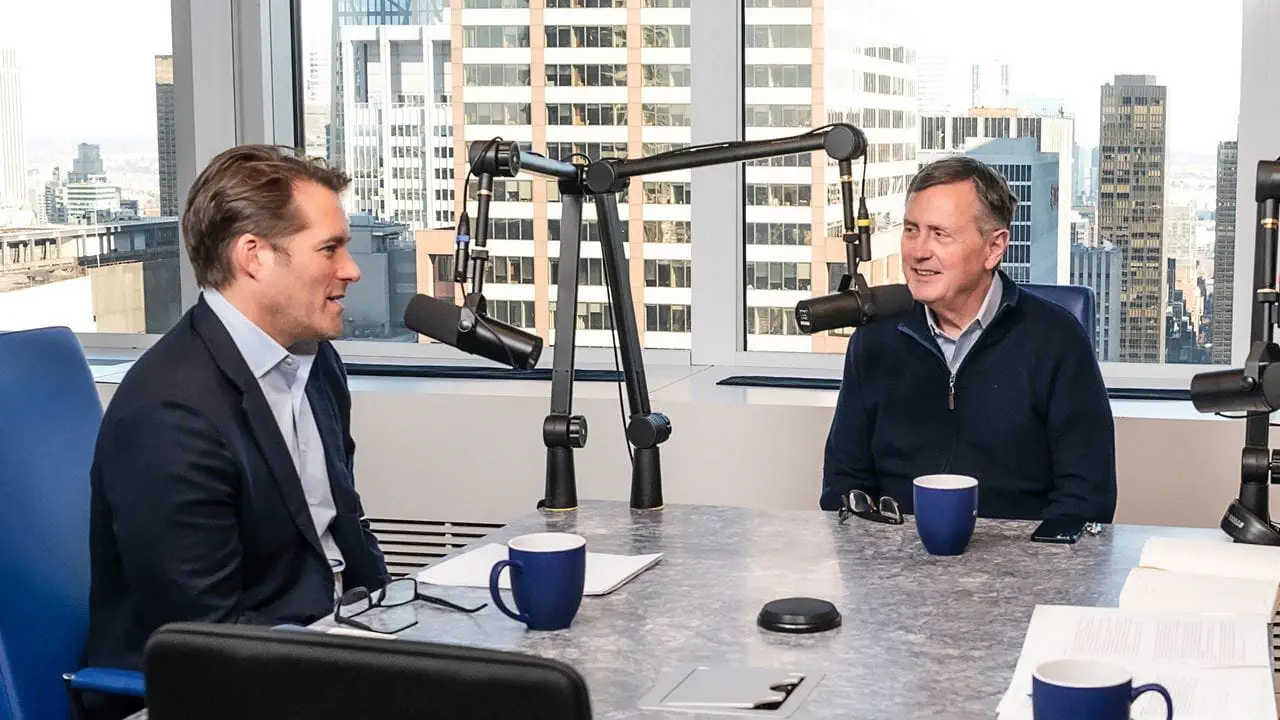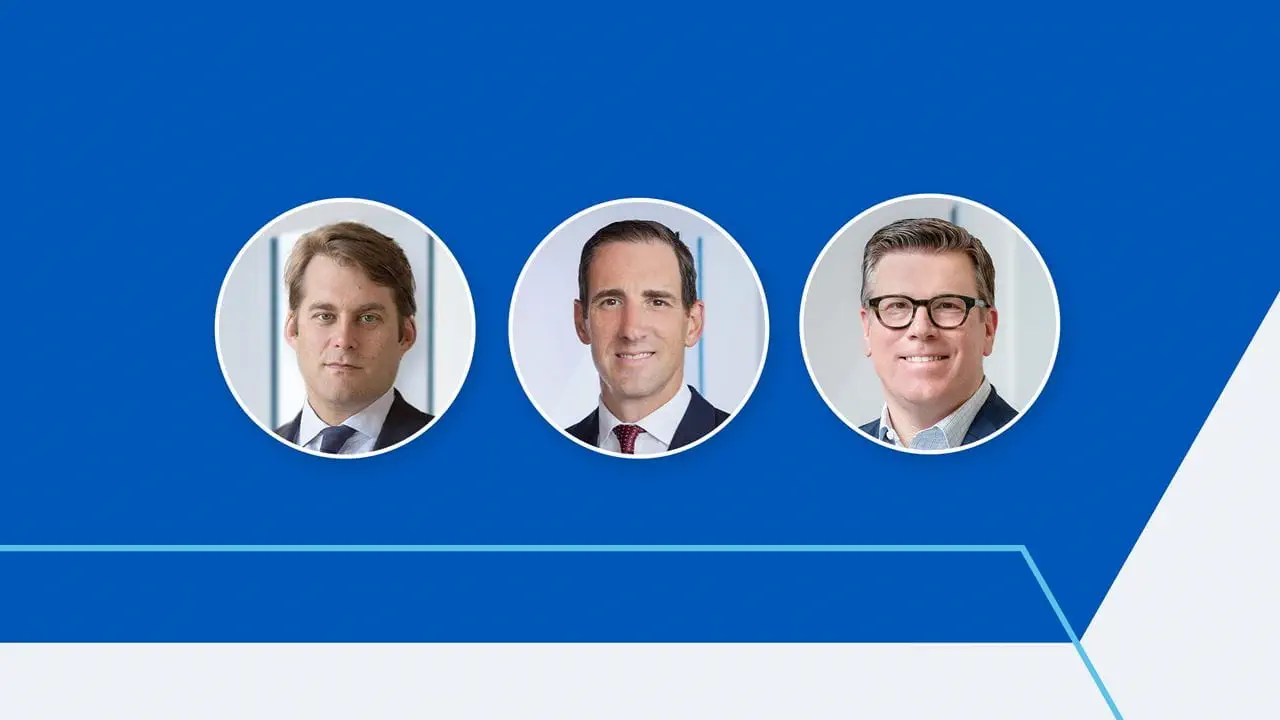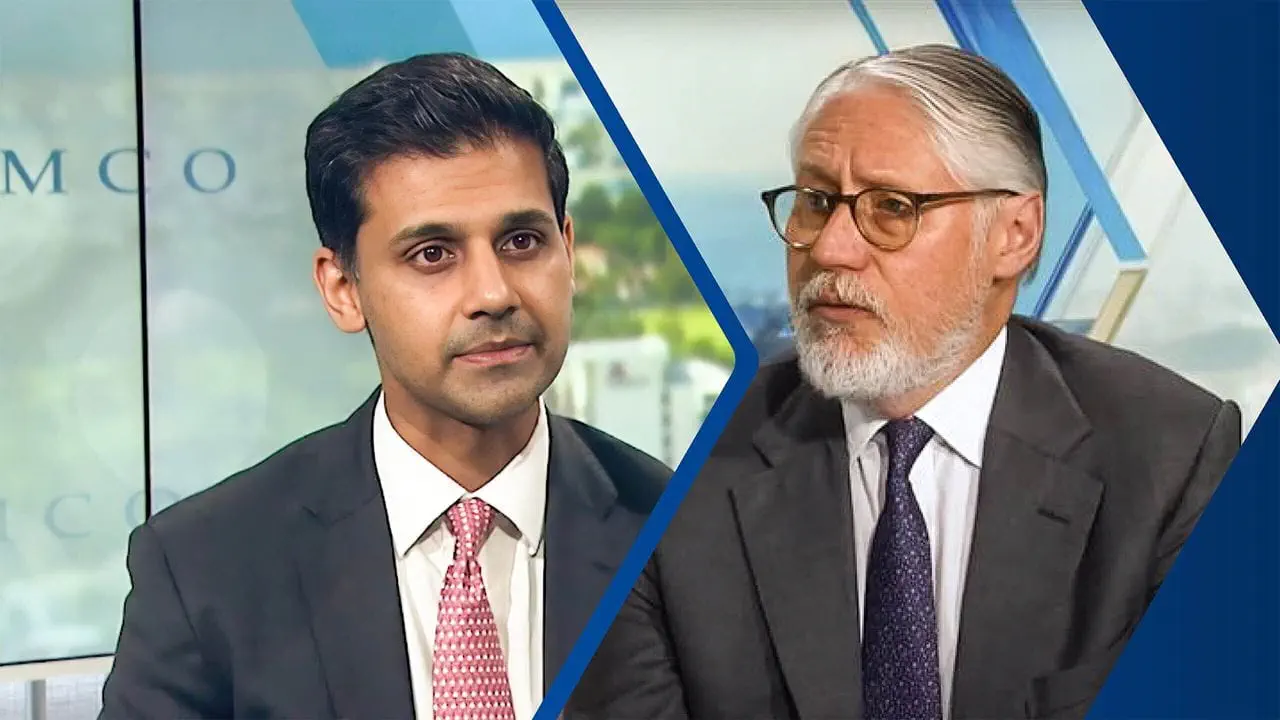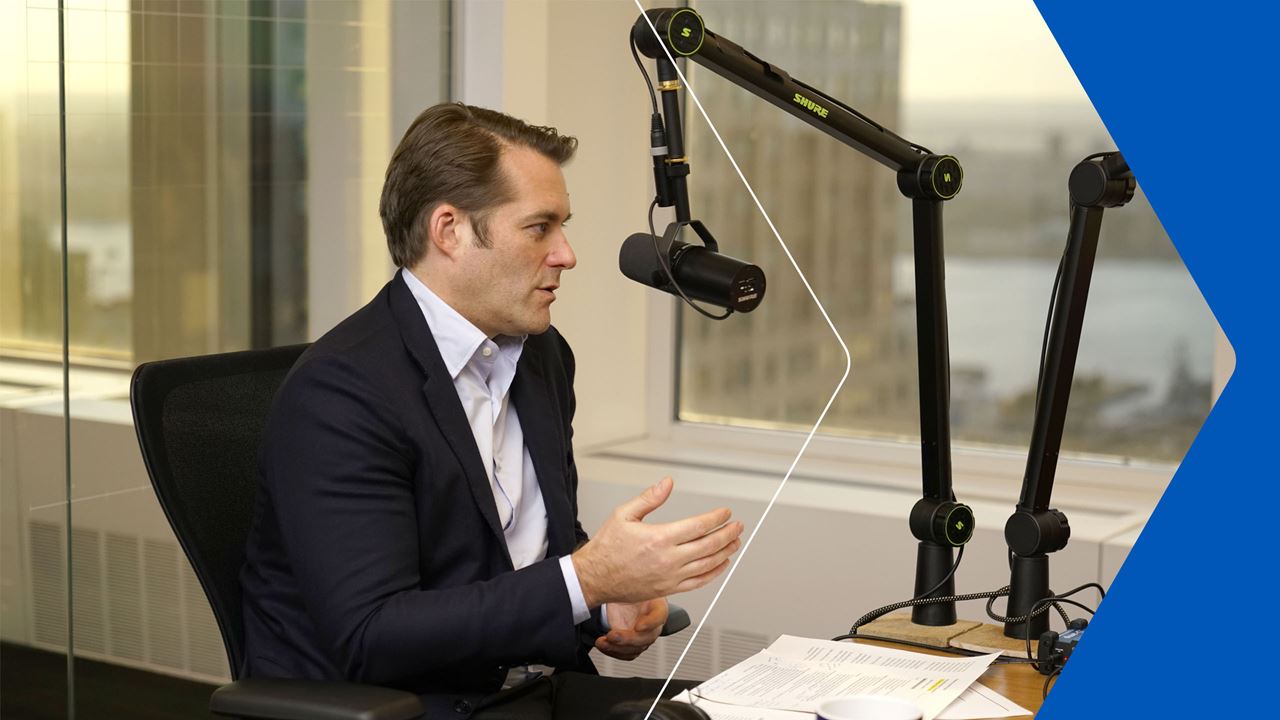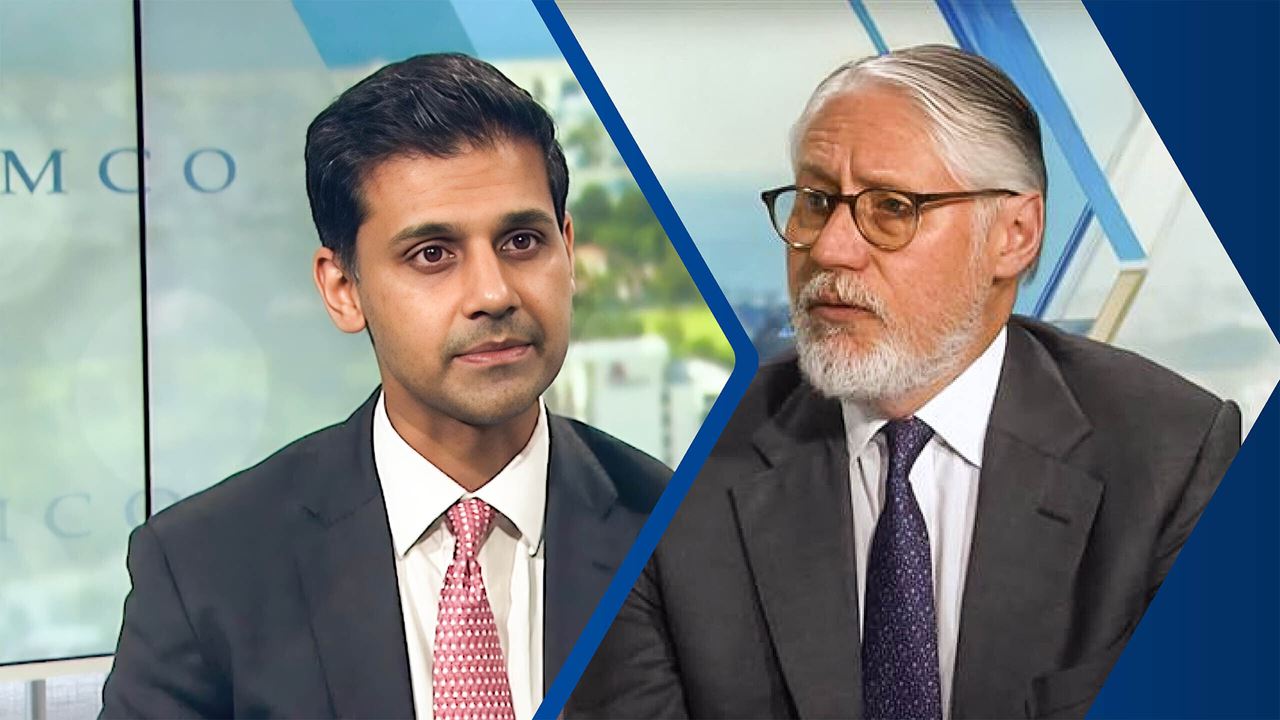Please stay tuned after the conclusion of the podcast for additional important information.
GREG HALL: Hi everybody. Welcome to another edition of Accrued Interest PIMCO's podcast, dedicated to financial advisors and their clients. My name's Greg Hall. I lead the wealth management business here in the United States, and I'll be your host for today. It's mid-year, It's June 16th. As we're recording this, it's a perfect time to check in with Dan Ivascyn, our group, CIO.
You'll all remember, I hoped that we’d have Dan on the podcast back in January to kick off the year. And we're going to try to maintain a pace here where we have him join us in January. Join us again in June, July. We can do a beginning of year outlook and a mid-year check in. I'll get into it a little bit with Dan as we talk through it. It's amazing to me how much has changed since the last time we spoke to him and how little has changed since the last time we spoke to him.
And so there's a lot of detail and content to unpack there in the conversation. I'd love to encourage you while I've got you here at the top of the podcast one please do subscribe. It's a great way for us to know who's out there, who's listening to us and make sure that we can tailor content that is appealing to you. Also encourage you to visit our website.
If you identify yourself as a financial advisor, you'll be taken to Advisor Forum which is our dedicated destination on the PIMCO website for you to access content and information that you as a financial advisor need to get it efficiently and make sure that you can spend as little time as possible getting exactly what you need from us and using that to fuel your conversations with your clients. So with that I'm going to move along to a conversation with Dan, who's joining me in our studio today. Dan, thanks for making the time for us.
DAN IVASCYN: Thanks, Greg.
GREG HALL: It's Good to have you on the East Coast. You've been here for a little while now, meeting with the investment team seeing some clients. And I think you let us know, the last time that we did this podcast, you, Massachusetts guy and grew up on the East Coast. It must be nice to be back home for you.
DAN IVASCYN: It is. I've been here for a couple of weeks in New York. Got to get back to Cape Cod over the weekend. Yeah. I have the kids and the family there. So it's nice.
GREG HALL: Is that where you did Father's Day up at the Cape?
DAN IVASCYN: I did. How's that? It was a good time. Kids had fun. I got a card from my oldest daughter and some Tootsie Rolls, which were nice.
GREG HALL: That's great.
DAN IVASCYN: But no, we had a nice time. It's a good time. Good time of year up there.
GREG HALL: I have teenagers. I mostly got eye rolls, but I did manage to get a hug or two out of 'em. Well you know, it's great to have you here. I was looking back, actually on the last time we talked for the podcast. 'cause I really just wanted to take a little bit of a stroll down memory lane and revisit some of the things we talked about, and then think about where we've been. So, you and I, sat in this room in late January of this year. And, had a pretty broad region conversation about markets, which we'll do again today. But let me just set the stage. I wouldn't say I was floored by this, but it is kind of interesting to me.
So, the ten year, the last time we talked was at 453. I checked it about five minutes ago, it was about 445. The S&P when we recorded last time at 6,071 today, 6,030, 6,040, or, six thousand thirty six thousand forty, give or take. The 30 year 4.78% the last time we spoke, it's backed up to maybe in the four nineties today.
The real change which we can talk about the dollar index down about 10% since the last time we spoke. But what really struck me, and the agg, let's mention the agg, the Bloomberg aggregate up about 2.7% for the year. And what really struck me about all that is putting the dollar aside, if you didn't know that April and Liberation Day had happened, and you just sort of checked in with us at those the last time we recorded this in today, the stability of those numbers. I mean, it's sort of an interesting thing, right?
DAN IVASCYN: It is, and it's felt like it's been quite volatile. It's felt like bonds haven't done so well. And again, I was looking at it from the beginning of the year and, last week, I think we literally hit the same yield that we started the year at. So a lot of movement. I think if we step back and look at movement across various global markets as well, you'd see a lot of localized volatility but at the end of the day if you just checked in every couple of months or so, you wouldn't think too much happened.
So, a lot of noise out there, of course. But you know, pretty good yields and pretty good returns.
GREG HALL: It funny that you said noise. 'cause again, I was going through the transcript and as we kicked off the conversation last time we had also just published our cyclical forum at the beginning of the year which is a research piece that we compose after the whole firm gets together and talks about, call it a six or a 12 month view, just to remind listeners what that is. And your view at the time as you were speaking to us, was basically, there's gonna be a lot of noise, but starting yields are really attractive and kind of base case is that bonds will generate their yield. And then you have some upside optionality if there's a drop in the overall rate environment, and you capture some total return.
And that to me is just sort of interesting. 'cause that's of course what's happened in the intervening time.
Maybe we should talk about the most recent forum piece. You just alluded to it. 'cause we had our secular forum I guess back in May now, and published this past week. We called it the Fragmentation era. What led to that title and what's kind of the main hypothesis of the report?
DAN IVASCYN: My sense is that it's just another reminder that we've taken a few steps back from these multi-year globalization themes and trends. We've talked about it now for a couple of years. We talked about it at the start of this year. We're in a really interesting investment paradigm.
One that's a little bit challenging for those that grew up learning economics, financial theory, discounted cash flow analysis. You know this came up, was at an event in London recently where one of our advisory board members framed it. Well, I think that through much of our careers, economics or financial market outcomes tended to drive politics.
And you know, what we mean by that is that when economies are strong and when financial market pricing is positive or, when financial markets are doing well it tends to lead to good outcomes for those politicians in charge. Today's world's different. Today we have a variety of geopolitical themes, political priorities that are driving economic outcomes. I think tariffs are probably the, the best example of that. But there's certainly other themes or cross currents at work as well.
This is leading to less synchronized markets. You saw it earlier in the year with Germany. The very uninteresting German market. And I say that respectfully, typically people are willing to give yield by moving into a predictable market governed by strong fiscal prudence.
And in return they get a relatively low volatility type environment. But they have to give up a little bit in yield. And of course, we were surprised, this year by Germany pivoting quite significantly towards the mindset of spending more money on defense, strengthen their own economy. And just one small example of how we're in an unpredictable world, a world with more frictions than we've grown accustomed to.
And it poses some risks for sure, but it also creates great opportunity for investors to take a global opportunity set into consideration to delve into markets they may have understandably forgotten for many years. And it's an environment that's fun again, exciting from the standpoint of generating a little bit of additional alpha on top of the attractive yields that you mentioned at the start of our conversation today.
So that's really the key theme is that what may appear irrational from a financial market's perspective can be quite rational when you take some of these longer term political considerations to heart. And of course, that involves a lot more input from policy experts, monetary policy people that understand the priorities of various administrations around the globe. And we're fortunate to have a lot of those folks Around PIMCO. And they have gotten even more involved in our investment process more recently.
GREG HALL: Yeah, sure.
I feel like I recall this conversation maybe creeping up into some earlier forum discussions, maybe going back to Trump 1.0 when the president sort of initially was signaling some of his reservations about NATO. And that maybe your recollection may be different, but what I remember is that sort of prompting us to think about a world that was less synchronized, where economies would seek to maybe protect themselves or consciously to borrow a popular phrase to consciously decouple a little bit.
And so I would imagine that, from your standpoint and how you've chosen to sort of surround yourself with advisors here at the firm, surprising certainly, but not outta the clear blue sky, right? This is something that we've been expecting to some degree for a little while.
DAN IVASCYN: Yeah. I think that's right. And we certainly got a flavor of Trump's priorities during his first term. We also got a flavor of the style and how Trump approaches various issues including negotiations.
With that said I think it's safe to say that the markets and us to a degree were surprised by some of the administration's approaches thus far. Liberation day tariffs, of course being higher and using a calculation that surprised the markets even some of the foreign policy initiatives around Greenland, Canada. Just the style, and I think that's important in an environment like this one is to try not to get whipped around by the noise. Try to understand that we're in a different paradigm.
Try to use every tool in the toolkit, so you don't need to take highly concentrated bets, but just appreciate the fact it's gonna be different. And you need to take a creative approach to analysis here. And I think if you do so as I mentioned earlier this is an incredibly target rich environment. It was back during the first administration, but now we have a real value advantage.
Higher yields is a starting point. And that's quite exciting to have the ballast in the predictability of very high cash flow, at least in a fixed income context, and then be able to generate return for clients relative to passive alternatives in a volatile and rapidly changing environment.
GREG HALL: How do we want to get to specific investment outlook and talk about markets, but how do you help the team and how do you personally sort of check cognitive bias and avoid letting some of the chaos? Again, I don't mean that disrespectfully, but just the volatility, for lack of a better word, around so many different poles from whipping us around, causing us to overreact.
DAN IVASCYN: I think the first step is just realize there's gonna be emotion that gets in the way of good objective decision making. This is an environment where people have different political perspectives and where style can get people riled up. On both extremes of the political spectrum. I'd like to think at PIMCO for many years we've put structures in place to help us make good sound objective decisions.
You know, Bill Gross was very strong personality, very well known in terms of views. But he really left us with a lot of investment structure. You mentioned our forums where to avoid the noise we get everyone together without side, real solid contrarian thinkers once a quarter. That was important, almost 27, 28 years ago when I joined the firm. I think it's especially important today where you have X and Instagram and other–
GREG HALL: Yeah. There's a lot more noise.
DAN IVASCYN: Constant noise to avoid. So, again, easier said than done, but I think good structure matters. And then I've said this before. I've always been a big fan of the behavioral finance literature. I think all of us have read it to some degree fault victim to some of these themes, overconfidence. I think us as well on the portfolio management side.
We're certainly a group that's prone to overconfidence. I think the longer you do this and are reasonably successful, the more you can succumb to these types of temptations, things like confirmation bias seeking out information to support a view you already have. I can't tell you how many times I'll get sent an article that's typically quite consistent with a person's investment views and political views as well. And I think, again, I fall victim to that from time to time, we have a great consultant in this area that has embedded herself as Anastasia Buyalskaya
GREG HALL: Yeah.
DAN IVASCYN: And, and others into analyzing the way we make decisions and constantly looking to enhance our process. So I think in this type of environment, it's more important than ever. And being able to make good, solid, objective decisions when other areas of the financial markets are not is an important source of alpha over time.
GREG HALL: Let get in a little bit in terms of macro. So we spent a lot of time the last time we spoke sort of talking about your outlook for the US economy for rates and inflation.
I think one of the things since we last spoke has, has maybe come to the fore in terms of advisor interest and advisor questions is fiscal sustainability in the US right? We will, the US, ultimately be able to finance itself. What will bond vigilantes maybe do in the long end of the curve over time? And, how does this really influence kind of the core, sorry, small c core appeal of fixed income in a portfolio. So is it okay, can we start there and then move into other areas?
DAN IVASCYN: Sure. So a couple of points there. First is we spent a lot of time looking at the US fiscal situation in an absolute sense, forecasting what it may look like over the next several years. And then more importantly, putting it in a historical context. And when we do that, there's some not so good news. And then some decent news there.
You know, the first point is that although over the last couple of months, especially with the focus on Dodge and Elon Musk's very direct views regarding concerns around debt and deficits it's been discussed a bit more than it had been discussed, but it's still not an important enough issue from a political perspective where we believe we'll see a meaningful improvement in deficits over the course of the next few years.
So, when we look forward and we do think that this big beautiful bill will get passed. It may not get passed before the 4th of July holiday, but it will likely get passed at some point before the end of the summer.
GREG HALL: More or less its current form or rhymes with its current form?
DAN IVASCYN: Probably pretty close to the current form. And actually to get it through the Senate it may lead to slightly higher deficit spending. Right.
GREG HALL: Okay.
DAN IVASCYN: In fact and again you know, what we see going forward are deficits in the five, 6% type range, give or take. And those are high they're especially high at a time where the economy continues to expand. So that's the concerning point when you step back and look throughout history and you take into account the significant advantages the United States has in terms of us still being the global reserve currency. And we said this in our secular outlook there, we're not losing that, Sue. I think it's fair to state that pretty definitively over the course of the next few years.
GREG HALL: Currency can weaken, but we're not, I don't wanna say we're not concerned, but it is not in your sort of realm of normal distribution that we should be worried about the US dollar being supplanted by something else as well.
DAN IVASCYN: Yeah. And I think that's the important second point though, is you could retain your global reserve currency status and still have your financial assets and currency underperform other parts of the world.
GREG HALL: Okay.
DAN IVASCYN: And we will talk about this later I'm guessing but I think the key point is when you look at the US fiscal position today relative to other developed market economies throughout history, even our own situation back in the eighties it does appear that the situation will be manageable, manageable — defined as, sure the markets in the yield curve will likely be more volatile that it's been in the past.
We've been a big proponent in suggesting that the yield curve will steepen, we've had that position on across portfolios. It's been quite profitable for us. And it's not just based on concerns around fiscal sustainability, but that is one reason why we do think curves will be steeper than they would be otherwise.
DAN IVASCYN: But, we do think when you look at the US you compare our country to other countries coming outta the first or in second World War, when you look at debt service requirements today versus where they were back in the eighties it does appear that we have time on our hands. Now, again when I say this, it always feels like I'm coming across too complacent. I think that's a very important point is that we're not complacent here, there are other alternatives to just owning a lot of very long maturity debt issued here in this country.
GREG HALL: Yeah.
DAN IVASCYN: You can diversify into other parts of the world that have a better fiscal picture, the same yields even in some cases, higher yields in US dollar terms and a less vibrant economy. That tends to be a pretty good combination for–
GREG HALL: For fixed income investors, yeah.
DAN IVASCYN: For fixed income returns. So, we've been doing a lot of that. And then again, I'm not solely based on concerns around debt sustainability. We have been owning more intermediate maturities and not venturing out in the long end as much as we would otherwise. One point I like to make though it's really hard in a narrow sense to time a bet against fiscal sustainability. I only have to go back a few years to 2023, if you remember the late summer of 23, we had the Fitch downgrade.
GREG HALL: Yeah.
DAN IVASCYN: Lots of concerns around deficits back then. A lot of concern about inflation back then. This was a time when the inflation numbers were much worse than they are today. And people were very focused on the Fed having to take rates materially higher perhaps up north of 5%. So that was a point in time when it turned out to be a great time to buy the long end of the yield curve. I think from the first week of October 23 into year end, the 30 year yield dropped by over one percentage point.
GREG HALL: I remember that. Yeah.
DAN IVASCYN: We've seen it in Japan as well for many years betting against fiscal sustainability there. So, it's an area of focus, it's an area of concern. If we do not get deficits down investors, including PIMCO, will look for other alternatives, look to diversify away from US assets, but we don't think it's a crisis just yet. In fact, one of the reasons why we're able to earn a very attractive yield lending to the US government as a private market participant is because of higher deficits. So in some sense it's not all bad.
The higher these deficits go the longer they remain, the higher the government's going to have to offer us in terms of yield in order to lend to them. So again, a complex situation. We are diversifying like many other investors, but we think that some of the concerns in terms of a crisis around the corner are a bit overstated.
GREG HALL: I think the last time we spoke you made the point happy to lend to the US government, kind of with a three to five year time horizon maybe a little bit less excited, 20 to 30 years. Is that a good kind of barometer for your feelings on duration right now?
DAN IVASCYN: It is we like duration here. And we like duration because yields are high. Nominal yields are high. Even when you subtract today's inflation rate you're still left with a pretty attractive return. And then across most markets we operate, we prefer that intermediate part of the curve. Some of it's tied to the fiscal situation.
A lot of it's just tied to the fact that we see better value there, a bit more clarity in terms of what's likely to occur over the next few years versus 30 years. And then a more complicated argument or complex argument is that the part of the maturity sweet spot where if we were to have a hard landing scenario, if we were to have a recession at some point over the course of the next year or two we believe that's the part of the curve that will likely outperform.
GREG HALL: Yeah. I wanted to ask you about economic fundamentals then. Has anything kind of post liberation day, given, maybe we know a little bit more about the, any stimulative qualities of the tax bill? What do you think of, over the cyclical horizon as it relates to the economy and recession fears, likelihood of more aggressive Fed action or the need for that?
DAN IVASCYN: Yeah. So there's a lot of uncertainty. And maybe I wanna be clear here. We have some great economists. We have Richard Clarida recent vice chair of the Federal Reserve, Tiffany Wilding, Allison Boxer, I could go on and on that they are really good at forecasting…
GREG HALL: All our podcast guests and not, we have to have Allison on, but Okay. But Rich and Tiffany have been on recently. Yeah.
DAN IVASCYN: And what we say to both Rich and Tiffany is that we want your forecast for growth and inflation and other key economic data without overlaying of US, to how the Trump administration may ultimately be negotiating tariffs, whether they're gonna step back or not from the very high tariffs that they have initially put in place.
We have Libby Cantrill, we have other advisory board members to do that type of analysis. So we want just pure economic forecasts based on the assumption that what's currently in place will remain in place. And under that framework, we've had a massive shift in our thinking around recessionary probabilities what inflation may do over the course of the next few quarters. I think at one point in time we're up around 60%, 65%.
GREG HALL: Yeah. Probability…
DAN IVASCYN: Probability of recession over the next 12 months. Today we're somewhere around a 35% probability. So above the typical 20% probability, even if you have no view on the economy. But I bring that up only because it's another example of just how uncertain this economic environment is because the policy environment's quite uncertain on the inflation.
So basically where we are today we think the US economy probably grows in the low to mid 1% range for 2025. We see inflation hovering somewhere in the 3% range, give or take primarily higher because of the tariff policy that we believe will remain in place somewhere an effective tariff rate. Somewhere in the low teens as an example.
And again, our recessionary probabilities are somewhere in that 35% range. So since liberation day we have become more constructive on the near term forecast for the economy, primarily because the tariffs have been ratcheted back.
GREG HALL: Right.
DAN IVASCYN: And then the point on the big beautiful bill or the fiscal package a lot of this is an extension of tax cuts that were already in place but there's gonna be some new measures that are stimulative.
And the structure of this bill is such where a lot of the stimulus is gonna be more front end loaded with the revenue offsets coming at some point two or three years down the road. So on the margin if we get through this period of more extreme tariff uncertainty, if they remain somewhere close to where they are now, which is a big, if we still think that they're gonna be more sector level tariffs coming we'll have to wait and see on the China situation, which is far from resolved.
DAN IVASCYN: Right. And there'll likely be some more targeted tariffs introduced across countries that received the benefit of this grace period. But our general sense is this will be a market where we continue to see some negative impact from tariffs over the course of the next few quarters on the positive fiscal, and I say positive in a narrow sense the stimulus will likely kick in early next year. The net result will be slower growth here. Inflationary pressures lingering higher for longer, but the base case is slow growth, not a recession.
GREG HALL: What do you think that means then, for credit? The last time we spoke, that was an area I think you were prepared to be, you were concerned about and prepared to be more concerned about just kind of given recessionary views now that we've rolled back from a 65% probability with 35% probability. How are you thinking about the corporate sector, the consumer sector?
DAN IVASCYN: Sure. Well, let let me step back for a minute. This has been a very unique environment for credit in general. And it's really been unique since coming outta the global financial crisis back in the 2008, 2009 period. That was the last example of sustained volatility in markets. Now, you may say, well, wait a minute. We had a global pandemic, you know, just a few years ago…
GREG HALL: Keyword was sustained. Right?
DAN IVASCYN: Sustained. I was gonna say that sustained is the key point, you know? Yes. We had the biggest shock to lifestyles in economic growth in our lifetimes but we also had the largest fiscal and monetary response as well. So this was a period where you should have in theory, had a cleansing period across markets getting some of the weaker corporate entities outta the market that's typically what happens when you have a negative growth shock of that degree. But it didn't happen.
So when you step back and you look at the most economically sensitive areas of the credit markets, the leveraged lending space more broadly it's been incredibly one way since the GFC, strong performance for those that went down in credit quality. Typically picking the highest yield, the lowest rated, most economically sensitive areas of the market. And you would've done the best.
GREG HALL: Yeah.
DAN IVASCYN: In this uncertain world we live in today with elevated recessionary risk we just see much better value in other areas of the market. We think investors could take advantage of higher quality sectors of the market, sectors of the market that are better fundamentals, even better technicals up to some degree take advantage of a global opportunity set and end up in a much better place.
Similar yields but a much more resilient profile if we were to have a harder landing type scenario. And I always remind folks that if you never have a recession, you don't know what's resilient versus what's not resilient. I remember going all the way back to the mid two thousands when us home prices just kept going higher and higher and higher.
It took a long time to figure out that this lending was getting excessive, that there weren't enough quality borrowers deserving of credit extension back then. We know that ended poorly. So I don't wanna sound overly inflammatory here, but we do think the combination of tight spreads deteriorating fundamentals, weaker covenants have created more risk than reward in certain segments of the leverage lending market.
Mostly the floating rate areas of the market. I also say that regulators hate bailing out the same sectors twice. And going back to the GFC, it was consumer lending, it was mortgage lending that caused all the problems. The banks caused a lot of trouble. And as we know those sectors have been massively over regulated coming out of the global financial crisis.
So we really enjoy today. And think it makes a lot of sense leading to the consumer, the US, Europe, even other parts of the world. You've had a significantly improving household balance sheet over the last 10 to 15 years while government balance sheets have put on more in more leverage similar dynamic in the corporate markets, investment grade companies in pretty good shape companies that issued in the high yield market in better shape.
A lot of the excess this time has migrated into the more risky areas of the non-financial corporate credit markets. So, again, not surprisingly, in our public strategies and our private strategies big overweights to asset backed at asset based lending, looking for other high quality proxies that offer attractive yields, agency mortgages senior structured products, a lot of times with a true Triple A, Double A, single A type.
Solid investment grade rating defined as a PIMCO rating after doing our own internal credit work. There's a bit too much of a reliance on external ratings at the moment. Echoes back to the mid-nineties and the mid two thousands when radio agencies were very involved in driving various forms of financial engineering.
And we are, the market, not surprisingly, after many years of strong credit performance are beginning to suggest that a rating agency investment grade rating is as good as the bottoms up work you can do with more sizable teams in markets. So those are some of the high level thoughts in an area where we have tremendous conviction at the moment.
GREG HALL: Yeah. You're not trying to be inflammatory and you're not being inflammatory. There are, from your description, there's a lot of things that do sort of rhyme with the pre financial crisis complacency. It's always nice to be told what you want to be true.
And so when somebody, if it's a rating agency or anybody tells you something's worth par when you're concerned it's not, I would imagine that feels good for a lot of investors out there and for a while now that there's been no consequence to maybe not thinking about that more deeply and really interrogating your position what I would say it's been interesting to me just over the last couple of months, Dan in being out there talking to advisors and going to a few conferences.
I will say I think the typical advisor we speak to is getting a little fatigued with some of these. It's funny you refer to them as lower quality areas of credit because the borrowers are in fact smaller and more leveraged and they're not always that those forms of lending aren't always pitched that way, I think, to financial advisors being referred to as lower quality.
But there's been, for the first time that I can remember in the last few years, some real fatigue developing around that storyline and a real desire to diversify into other areas of be it public or private credit, which seems, which feels very healthy, right. As advisors have a bigger menu of things to do. We, we had Kris Kraus on the podcast for the last episode talking about asset-based lending, talking about real estate lending in different areas that we're exploring right now that are less crowded, less competitive, maybe still offer some excess return relative to a unit of risk or liquidity.
DAN IVASCYN: Yeah. I think that's right. And again, it's been a remarkable run for strategies or sectors that represent loans to lower quality more economically sensitive corporate borrowers. A lot of these are smaller companies that have historically underperformed their larger cap counterparts during periods of economic stress.
And then you had the 2022 experience where public stocks went down and went down quite a bit. And owning some bonds didn't help. And you had an even more powerful sell off in longer maturity, high quality bonds. So not only has the absolute performance in the more economically sensitive areas done well, but the relative performance was quite striking back then. And it benefited not having to get marked to market. So there's probably been a touch of complacency in certain pockets of the market in that regard as well.
But what we look forward to today and you look at opportunities to generate attractive yields both in the public and the private segments of the market, and be able to obtain significant resiliency for clients. It's an incredible asset allocation opportunity or relative value opportunity, in fact, and I really make these bold statements, but it's one of the most obvious and attractive relative value opportunities I've seen in my entire career. And again, you won't know it until the economic shock happens. And then the one area that we didn't talk about today is tech innovation.
GREG HALL: Right.
DAN IVASCYN: I know a lot of focus on US deficits, US debt levels, but we have an incredibly dynamic economy. We have an incredibly strong tech sector, and we have what very well could be a multi-year period of significant change tied to artificial intelligence and technological innovation that can be very positive for the economy as a whole. It can be very positive for stock markets as a whole, but the more productive this technology becomes, the more disruptive it can be to old economy, leverage lending models. And I think that's something that may rear its ugly head in a very subtle but potent fashion.
GREG HALL: I heard you make this point the other day and I hadn't heard you say it before, it just struck me as so abundantly true at the time. It so much of deal activity over the last five years has been in the software sector, and you'd look to that sector and say, where are we as likely as anywhere else to see disruption from AI from other forms of new technology displacing existing technology? And it's interesting because we say old economy, but very recent economy could be disrupted by AI.
DAN IVASCYN: Absolutely. Right. And I think when you step back and you look at markets today, you look at how competitive certain areas are from an underwriting perspective a global environment of significant macro uncertainty, geopolitical uncertainty, where tariffs are going up and where there's the risk of trade wars or tit for tat increases in tariffs combined with massive disruption from a technological perspective and higher for longer rate scenarios that this wouldn't be an environment where you'd say, Hey, look, let's give up liquidity for five or 10 years and lend to companies in a highly levered manner or put more debt on old economy companies. So again the macro picture has changed a lot the last few years as spreads have tightened as protective covenants have deteriorated.
Again, now I am sounding a little bit more alarmist. That's not meant to be my goal here. It's just again, the fact that you do not need to subject yourself to this type of uncertainty. There are great opportunities and asset backed or asset based lending, they're pockets of the market that haven't grown as significantly where you can issue to a company on a fixed rate basis where they're not as susceptible to these higher for longer type front end rate scenarios.
So it hasn't mattered up until this point. It very well will matter over the course of the next few years. And again we're still talking about an environment today where you can generate returns within a broad fixed income opportunity set, depending on how much complexity you want to take on.
So it's an exciting time. But we do believe that this is an environment where you want to be more selective. You wanna be a little bit skeptical of markets that may have grown too quickly. And the great news is there are very logical solutions or alternatives.
GREG HALL: Let me ask you, I'm curious, you mentioned giving up liquidity, and I've been thinking about this a lot. People talk about the liquidity premium and you often hear it described almost in static terms, like the liquidity premium should be 200 basis points.
And I wanted to ask you, do you think of it as a fixed item or, or given the volatility and the kind of spread of outcomes that you see available in this environment that's more fragmented than maybe where we were five, six years ago? Like, what is the value of liquidity to you, and how do you think about that even mathematically when you're making decisions public versus private and portfolios?
DAN IVASCYN: Yeah. So we will make the decision based on the particular mandate that we're running on behalf of clients. We run daily liquidity vehicles. We run permanent capital vehicles where all of the liquidity that our clients obtain, and it can be quite good liquidity are through an exchange and then we have everything in between. So what we try to do is we try to look at what the particular goals of our clients are in a respective strategy, and then look at the cost for going down the liquidity spectrum.
Now, it's never or rarely is it binary nature, super liquid, super illiquid. There's a whole continuum of different liquidity profiles we look to adjust to where you are on the liquidity spectrum to make these decisions.
One common and this is an area where we're really excited to talk to clients in more detail, is that rarely are their apples to apples comparisons being made on liquidity pickup. I mentioned this earlier today in certain quarters there's this assumption that if you could find an investment grade rating on something, then it should be compared to some type of generic form of investment grade risk elsewhere. We know that's not true.
You don't need to move into the deeply illiquid space to pick up spreads in certain types of investment grade risk. A triple B CLO tranche is probably the best example. It always trades wide to a triple B industrial. It always trades quite wide relative to a triple B industrial, partially due to liquidity, partially due to complexity, but the bulk of the spread is because people in the market know it's a riskier underlying cash flow.
GREG HALL: Right.
DAN IVASCYN: Just one simple example. I think a lot depends on the mandate, but when we look at the pickup for going from something very liquid to something quite illiquid today, typically when you make a true apples to apples comparison that pickups on the order of 30 basis points.
GREG HALL: Wow.
DAN IVASCYN: Sometimes a bit more than maybe as much as 50 basis points. In certain cases where there's more complexity at times you're not picking up anything at all. And when you adjust for risk sometimes in this crazy world we live in today, with so much growth in certain private asset classes, you're actually giving spread.
GREG HALL: Right. So you're upside down.
DAN IVASCYN: So you're upside down. So all these are areas where it requires an ongoing discussion.
DAN IVASCYN: But I think the bottom line is, as my old colleague, Scott Simon used to tell me, I don't make it more complicated than it needs to be, maintain liquidity, liquidity can come in handy when you least expect it and get paid for going down the liquidity spectrum. I think what comes to mind, and listeners to the podcast can relate here.
It's just what's going on in the endowment community, the ultimate long-term model. Endowments tend to be perpetual in nature with a very long horizon. Just a year or two ago, people would've thought, wow, endowments are in a great liquidity perspective and in fact have the ability to go down the liquidity spectrum far more significantly.
An example of the uncertainty in the policy environment today. So many endowments at the moment are of the mindset that they don't have nearly enough liquidity, so things could change. And unfortunately, liquidity needs tend to be correlated to economic weakness. So when you have a recession people tend to need to tap into their 401(k), tend to need to tap into their savings when unemployment rates are elevated, when there's pressure on wages.
So again, we've had a pretty good economic environment for a long time. This is an area where, again certain investors will be able to give up liquidity, certain mandates at PIMCO give us the flexibility to take advantage of great opportunities within the less liquid segments of the market. But it requires nuance. It requires analysis. And it's not nearly as simple as saying, well, this you could find a rating agency to give me an investment grade rating therefore buy that, [UNCLEAR], something that's much more robust from a, from a credit perspective.
GREG HALL: Yeah. No, it's a great reminder that just because you can take on liquidity doesn't mean that you should. And I think because we've been in this sort of consequence free environment for a lot of different forms of risk it just, it's a good prompt, I think for a lot of the advisors listening to kind of just re-examine their assumptions about what that illiquidity really gets them.
Like if you're seeing 30 basis point or 50 basis point pickups not as a rule, but as a common, I don't think that's the kind of premium that people are looking to pick up in those strategies. And so it's a good reminder.
DAN IVASCYN: Yeah. Probably not. Having done this for 30 years just be careful of stories suggesting that we're in a new age and some new creative way to generate incremental return. Just be skeptical. With that said, great opportunities within the public space there are areas to avoid.
There are great opportunities in the private markets and again, public private that's gonna be how things are framed. It really is a liquidity continuum and you just, again, need to do good old fashioned, solid credit work, acknowledging the fact that we're in a highly uncertain policy environment. If you do that you're gonna be able to pick up resilience for a client, again, hope that we don't need it.
But again, hope's not an investment strategy and we live in an uncertain world regardless of what we may expect in the near term, we wanna protect downside for our end clients and do so with an attractive competitive yield versus passive alternatives. And as I said, it's one of the more exciting environments to do that. But be careful and look to differentiate along the way through conservative underwriting.
GREG HALL: One of the pieces of good news, I think is we just had a big meeting of our sales team. Everybody dialed in. We have about 200 people on the phone. And I think one of the themes of that conversation is many of us have never seen an environment where advisors are so interested in different forms of diversification, whether it's non-US for, for US investors more globally for globally situated investors maybe re-examining alternative investments and coming back to more traditional investments or vice versa. But there's a lot to do out there.
There's a lot to talk to us about. We've got a lot of viewpoints. We'll link in the show notes to a lot of the material that we've referenced today.
Dan, just in closing again, the last time we spoke, I think your overarching view was there's a lot of risk in the world. There's a lot of unknowns. There's only so much that we can try to predict and build models and frameworks around, and then you've just gotta be able to react to what comes at you in a very structured and thoughtful way. But that starting yields and just the basic fundamentals of fixed income right now, really attractive, able to absorb and help you remain resilient through those risks.
From listening to you today, it doesn't sound like that viewpoint has really changed you. You've added new data, you've added new inputs and new information. But it sounds to me like your basic outlook on the fixed income category is pretty consistent with where we started the year.
DAN IVASCYN: That's right. A bit more favorable towards non-dollar denominated risk. So you had mentioned earlier that the dollar has been weak this year. We, across most strategies have had a dollar underweight. We think from that perspective and even more exciting global opportunity set. But again maybe finishing where we started in our discussion earlier in the year in the higher quality, fixed income opportunity set. It's just not that complicated.
You typically earn your yield if you have a three to five year type time horizon. We go back and look at the last 12 months, and you basically earn your yield. And then in the context of an active strategy try to pick up some additional returns through some thoughtful shifts in asset allocation.
Taking advantage of inefficiencies in markets and overshooting and relative value opportunities. So quite target rich, again a great environment to provide incremental return versus passive alternatives.
So it's exciting, although it doesn't feel that way every day when you get whipped around by the news. But be patient, I tell myself that every day. Tell the team that every day and just earn your coupon and then benefit from some local volatility and the ability to earn a little bit on top of that as well.
GREG HALL: Alright. Dan, thank you so much. That was a perfect way to sum up a pretty broad ranging discussion. If there's anything else that those of you listening wanted to dig in on let me encourage you one more time. Visit our website. If you identify yourself as a financial advisor, you'll be taken straight to the Advisor Forum.
That's our spot for you to access information, content that you need to fuel your client conversations. We will link in the show notes to a few of the individual pieces that were discussed, as well as maybe some of the outside research or outside authors that we referenced.
If any of the topics that we discussed today are of interest to you, please feel free to contact your PIMCO representative and ask us as much as you'd like. We're here to help.
From This Episode
Part 1 - From January to Now - An Evolving Investment Paradigm
Part 2 - The State of U.S. Fiscal Sustainability
Part 3 - Economics Fundamentals and the Big Beautiful Bill
Part 4 - Credit – Avoid Complacency and Look to Consumers
Part 5 - Don’t Overcomplicate Liquidity
Part 6 - Conclusion: What is the Opportunity Set Today?
Related Resources:
- Latest insights from PIMCO’s industry-leading experts, including Rich Clarida, Tiffany Wilding, and Libby Cantrill.
- Our Cyclical Outlook – looking out 6-12 months: Seeking Stability.
- Our Secular Outlook – looking out 3-5 years: The Fragmentation Era.
- Take a look at PIMCO’s Behavioral Science Edge.
- Ready For Anything at Advisor Forum.

